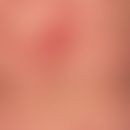Synonym(s)
DefinitionThis section has been translated automatically.
The complex physical decongestion therapy is a comprehensive therapy that can be used to treat lymphedema.
A distinction is made between the following areas in complex physical decongestion therapy.:
- Manual lymphatic drainage: The activity of the lymph vessels is stimulated.
- Compression therapy: reduces the ultrafiltration in the arterial leg of the blood capillaries
- Exercise therapy (lying compression): promotes lymph flow
- Skin care: Reduces the tendency to erysipelas.
There are also two phases of therapy
: phase 1: the decongestion phase. Daily manual lymphatic drainage with subsequent compression using short-stretch bandages, movement to activate the muscle pump and skin care. This phase lasts from two to four weeks.
Phase 2: The phase of conservation and optimisation. Specially made compression stockings are worn. In addition, manual lymphatic drainage is performed 1 to 2 times a week (often as a long-term therapy). If necessary, physiotherapy and skin care; 1 to 2 x per year, as described in phase 1.
EffectsThis section has been translated automatically.
By means of manual lymphatic drainage handles, the stretch receptors of the lymphatic vessels are activated, such as filling from the inside and an increase in lymphangiometry. Since 90% of the lymph vessels in the extremities run through the skin, gentle grips already have an effect.
Grips that are used for lymph drainage:
- scoop handle-
standing circle-
turning handle-
special handles to loosen the fibrosis.
The hand should lie as flat as possible on the skin. It is then moved in a circular motion, making use of its elasticity. However, the hand should not slip over the skin. In the direction of lymph drainage, a semicircle is created, which is emphasized by pressure from the hand. The second half of the circle is done without pressure.
Care should be taken to work slowly and evenly. The treatment is started in a centrally located area with peripheral extension. In addition, only gentle pressure should be applied to avoid hyperemia.
IndicationThis section has been translated automatically.
- Chronic lymphedema: In an outpatient therapy, the 2nd phase is in the foreground, mainly due to the temporal intensity of the 1st phase (mostly as an inpatient therapy; indication individual, depending on medical effort).
- Lymphedema, lipo-lymphedema
- Phlebödem: in chronic venous insufficiency (advanced stage of a venous disease). The early stage without secondary tissue alterations is an indication for compression and cold stimulation
LiteratureThis section has been translated automatically.
- Benke R et al (2012) In: André-Michael Beer, Martin Adler [Ed.] Leitfaden Naturheilverfahren für die ärztliche Praxis, Urban und Fischer Verlag p. 92ff.



